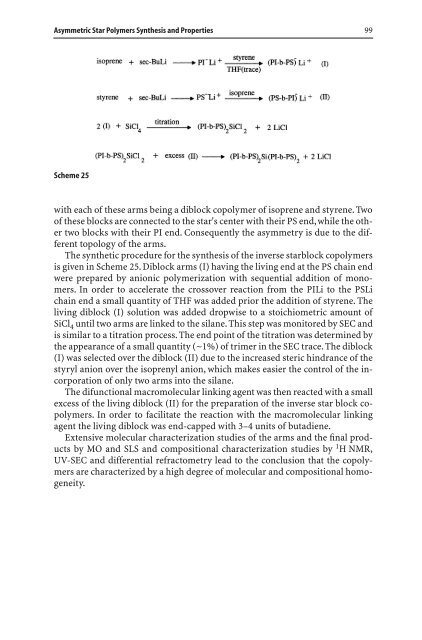142 Advances in Polymer Science Editorial Board: A. Abe. A.-C ...
142 Advances in Polymer Science Editorial Board: A. Abe. A.-C ...
142 Advances in Polymer Science Editorial Board: A. Abe. A.-C ...
Create successful ePaper yourself
Turn your PDF publications into a flip-book with our unique Google optimized e-Paper software.
Asymmetric Star <strong>Polymer</strong>s Synthesis and Properties 99<br />
Scheme 25<br />
with each of these arms be<strong>in</strong>g a diblock copolymer of isoprene and styrene. Two<br />
of these blocks are connected to the star's center with their PS end, while the other<br />
two blocks with their PI end. Consequently the asymmetry is due to the different<br />
topology of the arms.<br />
The synthetic procedure for the synthesis of the <strong>in</strong>verse starblock copolymers<br />
is given <strong>in</strong> Scheme 25. Diblock arms (I) hav<strong>in</strong>g the liv<strong>in</strong>g end at the PS cha<strong>in</strong> end<br />
were prepared by anionic polymerization with sequential addition of monomers.<br />
In order to accelerate the crossover reaction from the PILi to the PSLi<br />
cha<strong>in</strong> end a small quantity of THF was added prior the addition of styrene. The<br />
liv<strong>in</strong>g diblock (I) solution was added dropwise to a stoichiometric amount of<br />
SiCl 4 until two arms are l<strong>in</strong>ked to the silane. This step was monitored by SEC and<br />
is similar to a titration process. The end po<strong>in</strong>t of the titration was determ<strong>in</strong>ed by<br />
the appearance of a small quantity (~1%) of trimer <strong>in</strong> the SEC trace. The diblock<br />
(I) was selected over the diblock (II) due to the <strong>in</strong>creased steric h<strong>in</strong>drance of the<br />
styryl anion over the isoprenyl anion, which makes easier the control of the <strong>in</strong>corporation<br />
of only two arms <strong>in</strong>to the silane.<br />
The difunctional macromolecular l<strong>in</strong>k<strong>in</strong>g agent was then reacted with a small<br />
excess of the liv<strong>in</strong>g diblock (II) for the preparation of the <strong>in</strong>verse star block copolymers.<br />
In order to facilitate the reaction with the macromolecular l<strong>in</strong>k<strong>in</strong>g<br />
agent the liv<strong>in</strong>g diblock was end-capped with 3–4 units of butadiene.<br />
Extensive molecular characterization studies of the arms and the f<strong>in</strong>al products<br />
by MO and SLS and compositional characterization studies by 1 H NMR,<br />
UV-SEC and differential refractometry lead to the conclusion that the copolymers<br />
are characterized by a high degree of molecular and compositional homogeneity.
















